
grammatical foundations
.pdf
X-bar Theory
understood in this sentence: you! An imperative cannot be interpreted as a command given to some third person and must be interpreted as directed towards the addressee. The question is then, what is the status of the subject of such sentences: are they only ‘understood’, present at some semantic level or are they merely ‘unpronounced’ though present at the grammatical level?
There is reason to believe that language makes much use of unpronounced elements that are nonetheless present grammatically and we will see many examples of such things in the following pages. One argument to support the assumption of an unpronounced subject in (13) comes from observations concerning the behaviour of reflexive pronouns such as himself. Unlike other pronouns, reflexives must refer to something else in the same sentence:
(14)a Sue said Fred fancies himself b Sue said Fred fancies her
In (14a) himself can only be interpreted as referring to Fred and cannot, for example, be taken to mean someone else not mentioned in the sentence. Compare this to the behaviour of her in (14b). In this case the pronoun may either be taken as referring to Sue or to some other woman. We can say therefore that reflexive pronouns must have grammatical antecedents: some element present in the sentence which provides the reflexive with its reference. With this in mind, consider the following observations
(15)a Pete ate the pie by himself b Pete ate the pie by itself
(16)a eat the pie by yourself! b Pete ate
c *Pete ate by itself
As we see from (15), a by phrase containing a reflexive is interpreted to mean ‘unaccompanied’. In (15a), the reflexive refers to Pete and so it means that he was unaccompanied in eating the pie. In contrast, in (15b) the reflexive refers to the pie and so it means that the pie was unaccompanied (by ice cream for example) when Pete ate it. (16a) is grammatical even though there is no apparent antecedent for the reflexive. It is not surprising that the reflexive should be yourself however, as, as we have said, the understood subject of an imperative is you. Yet we cannot simply say that the antecedent ‘being understood’ is enough to satisfy the requirements of the reflexive as (16c) is ungrammatical. In this case the object is absent, though it is clearly understood that something was eaten in (16b). But this understanding is not enough to license the use of the reflexive in this case. So we conclude that the missing subject in (16a) is different from the missing object in (16c) and in particular that the missing subject has a more definite presence than the missing object. This would be so if the missing subject were present as an unpronounced grammatical entity while the missing object is absent grammatically and present only at the semantic level. In conclusion then, while imperatives might look like VP clauses which lack subjects, they are in fact full clauses with unpronounced subjects.
91

Chapter 3 - Basic Concepts of Syntactic Theory
If the VP cannot be argued to function as a clause, one might try to argue that clauses and subjects have certain things in common. For example, a clause can act as a subject:
(17)[that ice cream production has again slumped] is bad news for the jelly industry
But this does not show that subjects are functional equivalent to clauses but quite the opposite: clauses may be functionally equivalent to subjects under certain circumstances.
Therefore it would appear that clauses are exocentric constructions, having no heads, and as such stand outside of the X-bar system. Later in this book, we will challenge this traditional conclusion and claim that clauses do indeed have heads, though the head is neither the subject nor the VP. From this perspective, X-bar theory is a completely general theory applying to all constructions of the language and given that X-bar theory consists of just three rules it does indeed seem that I-language principles are a lot simpler than observation of E-language phenomena would tend to suggest.
1.3Heads and Complements
But if the structural rules of the grammar are themselves so general as to not make reference to categories how do categorial features come to be in structures? One would have thought that if all the grammar is constructed from are rules that tell us how phrases are shaped in general, then there should only be one kind of phrase: an XP.
To see how categorial information gets into structure we must look more closely at heads and the notion of projection. We have seen how heads project their properties to the X©and thence to XP, the question we must ask therefore is where do heads get their properties from? The main point to realise is that the head is a word position and words are inserted into head positions from the lexicon. In chapter 1 we spent quite some time reviewing the lexical properties of words, including their categorial properties. These, we concluded, are specified for every lexical item in terms of categorial features ([±F, ±N, ±V]). If we now propose that a head’s categorial features are projected from the lexical element that occupies the head position we can see that phrases of different categories are the result of different lexical elements being inserted into head positions.
One way to envisage this is to think of X-bar rules as building a general X-bar structure devoid of categorial properties. So we might start with the following:
(18)XP
YP X©
X YP
We then populate this structure by inserting words into it from the lexicon and these bring along with them their categorial features. Suppose we insert the verb fall into the head position, as this is categorised [–F, –N, +V] (i.e. verb) these will project to the head position:
92
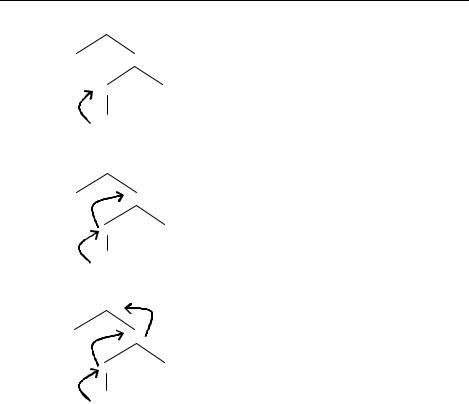
X-bar Theory
(19)XP
YP X©
V YP
fall
These features then project to the X©:
(20)XP
YP V©
V YP
fall
And finally they end up on the maximal projection:
(21)VP
YP V©
V YP
fall
In this way we can see that categorial features are actually projected into structures from the lexicon. This makes a lot of sense given that categorial properties are to a large extent idiosyncratic to the words involved in an expression and are not easily predicted without knowing what words a sentence is constructed from. Things which are predictable, such as that all phrases have heads which may be flanked by a specifier to its left and a complement to its right, are what are expressed by the X-bar rules. Thus we have a major split between idiosyncratic properties, which rightly belong in the lexicon, and general and predictable properties which rightly belong in the grammar.
The structure in (21) is still incomplete however and we must now consider how to complete it. Let us concentrate firstly on the complement position. At the moment this is expressed by the general phrase symbol YP. This tells us that only a phrasal element can sit here, but it does not tell us what category that phrase must be. Yet, it is clear that we cannot insert a complement of just any category into this position:
(22)a fell [PP off the shelf] b *fell [DP the cliff]
c *fell [VP jumped over the cliff]
This restriction clearly does not come from the X-bar rules as these state that complements can be of any category, which in general is absolutely true. But in specific cases, there must be specific complements. Again it is properties of heads
93
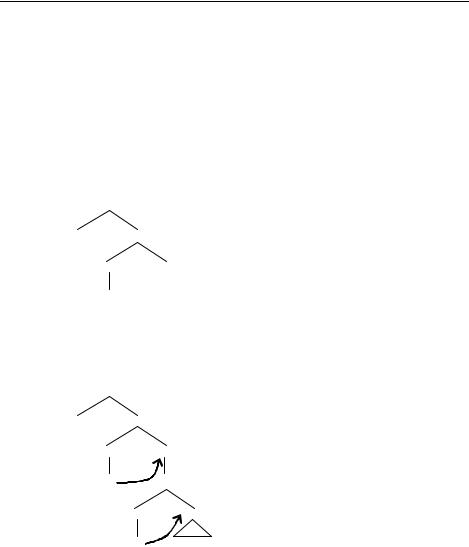
Chapter 3 - Basic Concepts of Syntactic Theory
which determine this. Recall that part of the lexical entry for a word concerns its subcategorisation. The subcategorisation frame of a lexical element tells us what kind of complement there can be. For fall, for instance, it is specified that the complement is prepositional:
(23)fall category: [–F, –N +V]
-grid: <theme, path> subcat: prepositional
Thus through the notion of subcategorisation, the head imposes restrictions on the complement position, allowing only elements of a certain category to occupy this position:
(24)VP
YP V©
V PP
fall 
As we know that the complement must be prepositional, we also know by the general principles of X-bar theory that only a preposition could be inserted into the head position of this phrase and the lexical properties of this head will, in turn, impose restrictions on what can appear in its complement position:
(25)VP
YP V©
V PP
fall P©
P DP
off |
the shelf |
In this structure, off is inserted into the head position of the PP complement of the verb and as this preposition selects for a DP complement (as most of them do), only a determiner could be inserted into the head position of this phrase. The determiner would then impose restrictions on its complement, ensuring this to be an NP and hence only a noun could be inserted into the head of the determiner’s complement. Obviously, this could continue indefinitely, but in this case the process stops at this point as the noun subcategorises for no complement.
94
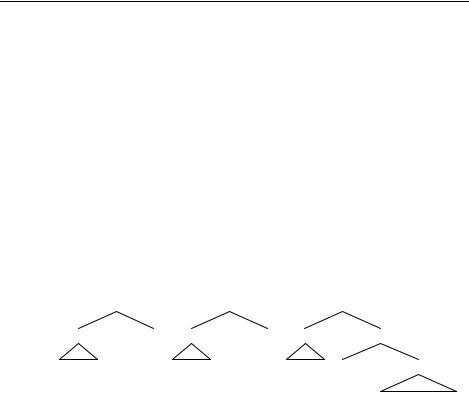
X-bar Theory
1.4Specifiers
So far we have been concerned with heads and their complements. In this section we turn to specifiers. As we said above the specifier position is a little more complex than the complement for reasons which we will turn to in section 2.
In general we will find that specifiers are occupied by certain arguments of a predicate or by elements with a certain specified property which relates to the head. This second class of specifiers can only be discussed after a good deal more of the grammar has been established, so we will put these to one side for the moment.
The argument specifiers tend to be subjects, though again this statement will need much qualification as we proceed. One class of verb for which this is most straightforward are those which have theme subjects:
(26)a a letter arrived b the ship sank
c Garry is in the garden
Simplifying somewhat, we might claim that these arguments sit in the specifier of the VP:
(27) |
VP |
|
VP |
|
VP |
|
|||
DP |
V© |
DP |
V© |
DP |
|
|
V© |
||
a letter |
|
|
the ship |
|
|
Garry |
V |
PP |
|
V |
V |
||||||||
|
|
|
|
|
|
|
|
in the garden |
|
|
arrived |
sank |
|
is |
|||||
These arguments are nearly always DPs and so, unlike the complement they do not seem to be restricted differently by different heads in terms of their category. This is reflected in the lexical entries of the relevant heads in the fact that subcategorised elements are always complements and subjects are never subcategorised for. Of course, there are restrictions placed on these specifier arguments from the predicate, but of a more semantic nature. The verb assigns a -role to these arguments and so the argument must be semantically compatible with the -role it has to bear. For example:
(28)the complete works of Shakespeare arrived
The most natural interpretation for this sentence would be to interpret the subject the complete works of Shakespeare as a book or set of manuscripts, i.e. something concrete rather than the artistic pieces of work themselves. Only if one was speaking about arriving in a metaphorical sense could one claim that one of Shakespeare’s plays had ‘arrived’ after he had written it.
This is different from the situation facing complements where there are both semantic and categorial restrictions placed on them. For example consider the following difference:
(29) a Arthur asked what the time was Arthur asked the time
bWonder woman wondered what the time was *Wonder woman wondered the time
95

Chapter 3 - Basic Concepts of Syntactic Theory
The verbs ask and wonder both have questions as their complements, but only with ask can this question be expressed by a DP like the time. Thus there are extra restrictions imposed on complements which go beyond the requirement that they be compatible with the -role that is assigned to them. In short, specifiers are more generally restricted than complements as they tend to be a uniform category for different heads and merely have to be compatible with the meaning of the head.
1.5Adjuncts
It is now time to turn to the third rule in (1), which we repeat here:
(30)Xn → Xn, Y/YP
This is different from the previous two rules in a number of ways. First, the previous rules specified the possible constituents of the various specific projections of the head: complements are immediate constituents of X© and specifiers are immediate constituents of XP. The adjunction rule in (30) is more general as it states the possible constituents of an Xn, that is, an X with any number of bars. In other words, Xn stands for XP (=X©), X©or X (=X0). The adjunct itself is defined either as a word (Y) or as a phrase (YP) and we will see that which of these is relevant depends on the status of Xn: if Xn is a word, then the adjunct is a word, if not then the adjunct is a phrase.
Note that the two elements on the right of the rewrite arrow are separated by a comma. This is missing from the complement and specifier rule. The significance of the comma is to indicate that the order between the adjunct and the Xn is not determined by the rule. We have seen that in English the complement follows the head and the specifier precedes it. Adjuncts, on the other hand, it will be seen, may precede or follow the head depending on other conditions, which we will detail when looking at specific instances of adjunction.
The final thing to note is that the adjunction rule is recursive: the same symbol appears on the left and the right of the rewrite arrow. Thus the rule tells us that an element of type Xn can be made up of two elements, one of which is an adjunct and the other is another Xn. Of course, this Xn may also contain another Xn, and so on indefinitely. In this way, any number of adjuncts may be added to a structure.
1.5.1 Adjunction to X-bar
Let us take an example to demonstrate how this might work. We know that an adjectival phrase can be used to modify a noun, as in:
(31)a smart student b vicious dog
c serious mistake
It is clear that the noun is the head of this construction as it can act as the complement of a determiner and determiners take nominal complements, not adjectival ones:
(32)a the [NP serious error] b the [NP error]
c *the [AP serious]
The bracketed elements in (32a) and (b) have the same distribution and hence we can conclude they have the same categorial status. As this phrase in (32b) contains only a
96

X-bar Theory
noun, we conclude that it is an NP. In (32c) however, the phrase following the determiner contains only an adjective and is ungrammatical. This clearly has a different distribution to the other two phrases, indicating that the adjective in (32a) is not the head of this phrase.
It is also possible to conclude that the adjective is not a complement of the head noun as it does not follow the noun and as we have seen, in English, all complements follow their heads.
The other possibility is that the adjective functions as a specifier within the NP and as specifiers precede their heads, this seems more likely. Yet there are properties of the adjective that make it an unlikely specifier. As we saw, specifiers of thematic heads tend to be arguments of those heads. The adjective is obviously not an argument of the noun as it does not bear a thematic role assigned by the noun. Furthermore, specifiers are limited to a single occurrence and there cannot be more than one of them:
(33)a the letter arrived
b the postman arrived
c *the letter the postman arrived
However, there can be more than one adjectival modifier of a noun:
(34)a popular smart student b big evil vicious dog
c solitary disastrous unforgivable serious mistake
Thus, the adjectival modifier is an adjunct of the noun. We will argue in a later chapter that adjectival modifiers follow the specifier of the NP and hence adjectival phrases are attached in a position between the specifier and the head. As we see in the following, this puts them as adjuncts to the N©:
(35) |
NP |
spec N©
AP N©
smart N
student
The part of the structure containing the AP is recursive with an N©as the mother and an N©as one of the daughters. This means that there is room for more APs, as demonstrated by (36):
97

Chapter 3 - Basic Concepts of Syntactic Theory
(36) |
NP |
spec N©
AP N©
popular AP |
N© |
smart N
student
This could go on indefinitely with each adjunct introducing an N©which itself contains an adjunct and another N©and hence any number of adjuncts could be added to the structure, which appears to be the correct treatment of adjuncts.
1.5.2 Adjunction to phrase
We can exemplify adjunction to a phrase with a certain type of relative clause. Relative clauses are clauses which are used to modify nouns:
(37)a the queen, [who was Henry VIII’s daughter]
b the sun, [which is 93 million miles from the earth] c my mother, [who was a successful racing driver]
These clauses are not complements of the nouns, the nouns in (37) all being intransitive, and cannot be specifiers as they follow the head. Like AP adjuncts, they are recursive, demonstrating a clear property of an adjunct:
(38)book, [which I was telling you about], [which I haven’t read]
We will see in a later chapter that there is reason to believe that these types of relative clause are adjoined to the NP rather than the N©:
(39) |
|
NP |
NP |
RelS |
|
|
|
|
N© |
which I told you about |
|
|
|
|
N |
|
|
book
In this case it is the NP that is recursive, the top NP node contains the relative clause and another NP. This means that there is room for further relative clauses:
98
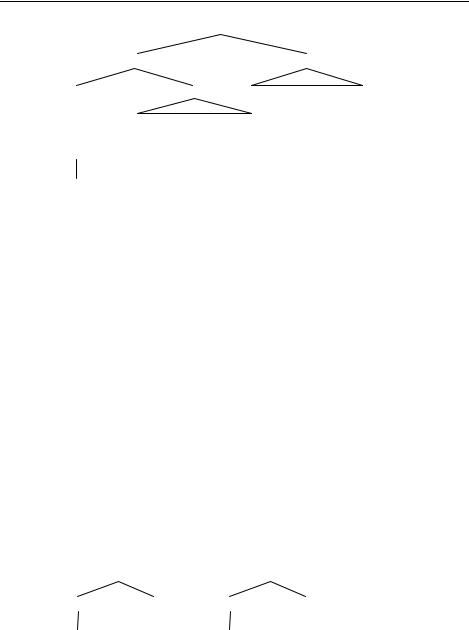
X-bar Theory
(40) |
|
|
NP |
|
|
NP |
RelS |
NP |
RelS |
which I didn’t read |
|
|
|
which I told you about |
|
N© |
|||
|
|
|
|
N |
|
|
|
book
Again, we could keep adding NPs and relative clauses indefinitely, each relative clause adjoined to a successively higher NP. Incidentally, note that here we see that adjuncts may appear on different sides of the element that they modify. While an AP adjunct precedes the N©, the relative clause follows the P.
1.5.3 Adjunction to head
Finally, we will consider the case of adjunction to a head, using compound nouns for an example. There are a number of complexities which we will not go into here, sticking to more straightforward cases. Compound nouns are formed by putting two otherwise independent elements, usually an adjective and a noun or two nouns, together and use the resulting unit as a single noun:
(41)a armchair b breastplate
c luncheon meat d blackbird
e tallboy
Sometimes the spelling indicates that the two parts of the noun are put together to form one word, but other times it does not. We will not delve into the mysteries of English spelling here. Note that when compounds are formed from an adjective and a noun, the noun is second. Moreover, if there is a main semantic element of the two parts of the compound, this is also the second element: an armchair is a kind of chair not a kind of arm. We might claim therefore that the second element is the head and the first is a modifier of the head. The structures we get are:
(42) |
N |
|
N |
||
N |
N |
A |
N |
||
arm |
|
|
tall |
|
|
chair |
boy |
||||
Given that the second noun is the head, it follows that the first element is an adjunct to the head. In principle, we should be able to get multiple head adjuncts by the same recursive process as we have noted with other adjuncts. However in practice it is not so common to find multiple compound nouns of this type. It is more common
99
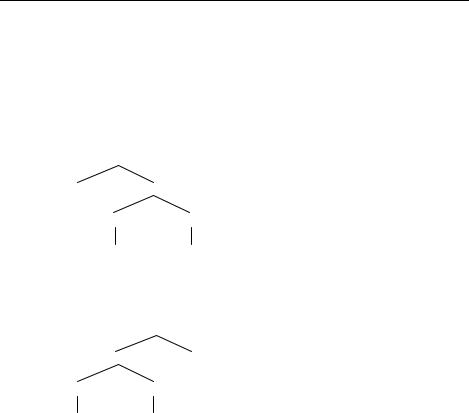
Chapter 3 - Basic Concepts of Syntactic Theory
to find the adjunct itself being made up of a compound, which has a very different structure. Compare the following:
(43)a computer hard disk b ballpoint pen
In both cases the last noun is the head, but the adjuncts are related in different ways. In (43a), the adjective hard modifies the head to form a compound hard disk. We then add the second adjunct which modifies this. Thus we have the structure:
(44) |
|
N |
|
N |
|
N |
|
|
|
|
|
computer |
A |
N |
|
hard disk
In (43b) on the other hand, we have a compound made up of ball and point, with the latter as the head. This compound is then used as an adjunct in the compound ballpoint pen, giving the following structure:
(45) |
N |
|
|
N |
|
N |
|
|
|
|
|
N |
N |
pen |
|
ball point
An interesting point to note is that the adjunct to a head is always a head itself, which differs from the previous cases of adjunction we looked at above. Adjuncts adjoined to X©or XP are always phrases. It has been suggested that this is due to a restriction on adjunction such that only like elements can adjoin: heads to heads, phrases to phrases. If this is true, then X©adjunction should not be possible as the adjunct differs in its X-bar status to the X©, being a phrase. We will not accept this point of view however and assume that while only heads can adjoin to heads, phrases can adjoin to any constituent larger than a head.
1.6Summary
Before moving on to look at other aspects of syntactic processes, let us consolidate what we have said in this section. X-bar theory is a theory of basic structure comprising of just three rules. These rules are generally applicable to all structures and substructures, no matter what their category: they are category neutral. The categorial status of a specific structure depends on the lexical elements it contains, in particular one word acts as the head of each phrase and this determines the category of the phrase by projecting its own categorial properties, established in the lexicon, to the X©node above it and ultimately to the XP.
100
